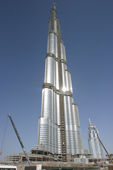Jan 15 2009
As a leading global partner to the construction industry, BASF is exhibiting at the World Future Energy Summit in Abu Dhabi, United Arab Emirates from January 19 to 21, 2009. The event is hosted by the project organization for the future city of Masdar, which aims to set new standards with a zero-carbon energy supply system. Masdar is scheduled to be ready for occupation by 50,000 people in 2016.

At the World Future Energy Summit exhibition BASF will have its own stand with the theme “More Efficiency from Less Energy”. BASF shows methods available today that can cost efficiently reduce energy consumption during the construction and use of buildings, cut carbon emissions and increase living comfort. BASF has an extensive range of products and system solutions in these areas that are modified globally to suit local construction industry requirements, architectural traditions and climate: “Chemical innovations substantially increase the energy efficiency of buildings in all climate zones and significantly reduce greenhouse gas emissions,” said Dr. Bernhard Hofmann, head of BASF’s Construction Chemicals division. “We thus aim to offer our customers in the construction industry the best concepts, economically and ecologically.” Dr. Thomas Weber, Managing Director of BASF Future Business, said: “BASF spends approximately one-third of its research and development budget on projects that help to use energy efficiently and thus protect the climate. Examples are solutions that make it possible to generate and store energy more efficiently or that reduce energy consumption.”
BASF plans to demonstrate the following solutions at the World Future Energy Summit exhibition:
Reducing carbon emissions during concrete manufacture
BASF supplies concrete manufacturers with high performance plasticizers sold under the brand name Glenium Sky®. The plasticizers preserve the quality of concrete during transport, make concrete easier to process at the building site due to enhanced fluidity, and produce completed concrete structures that have high strength and a long lifetime. In addition, Glenium Sky reduces carbon emissions during concrete manufacture. Adding Glenium Sky to concrete allows manufacturers to use cement types containing high amounts of carbon neutral supplementary cementitious materials. These materials replace one component of the cement, the so called clinker, which is manufactured in a highly carbon-intensive process. Thus, using Glenium Sky lowers carbon emissions by up to 60 percent. Using Rheomatrix® admixtures in combination with Glenium Sky saves even more energy. The admixtures give the concrete self-compacting properties that eliminate the need for high-energy compaction by machine.
Versatile polyurethanes – cladding, cooling, coastal protection
In the Gulf region, the construction and insulation markets offer a large range of opportunities for the high end polyurethane plastics Elastopor® H and Elastopir® supplied by the BASF Polyurethanes division. Sandwich elements, insulating boards and spray-applied rigid foam are ideal for energy-efficient, uncomplicated construction for industry and housing. Polyurethanes are the materials of choice for cold store insulation and for the cladding around cold air pipes. Rigid polyurethane foam is useful in hot climates for space-saving, efficient building insulation.
The specially developed elastomeric polyurethane system Elastocoast® is designed for coastal protection. Elastocoast® is a polyurethane-rubble combination that bonds stone layers permanently at selected points in the breakwaters of coastal defense systems. The stone layer created is highly stable, extremely resistant and open-pore. Unlike rigid surface constructions made of concrete or bitumen, the rubble layer clamped by Elastocoast absorbs the energy of impact of incoming water masses and prevents stone surfaces from rupturing.
Neopor® saves on energy for cooling
Neopor is an innovation for the insulation of building exteriors, roofs and floors. Inbuilt infrared absorbents and reflectors give Neopor an insulation performance 20 percent higher than that of other insulating materials, in this manner keeping room temperature constant and helping create a pleasant living environment. Figures calculated by the Passivhaus Institute Darmstadt show that thermal insulation with Neopor significantly reduces the incidence of overheating and the hours of active cooling in warm climatic zones. Depending on the type of dwelling and construction style, Neopor thus cuts cooling energy by at least 30 percent and lowers carbon emissions. The BASF stand will demonstrate Neopor insulating panels and insulating concrete forms (ICFs).
Wall systems for greater energy efficiency
BASF also presents novel wall systems available under the Senergy® brand name. The systems are composed of multiple layers for the insulation and protection of exterior surfaces. These solutions enable buildings to be cooled in an efficient manner, so reducing energy consumption. Senergy systems are also decorative and open up new flexibility in terms of exterior design.
Black pigments reduce surface heat
BASF will also be showcasing black pigments for reducing surface heat: Paliogen®, Lumogen® and Sicopal®. Unlike the soot pigments in common use, BASF’s pigments prevent the absorption of the invisible near infrared radiation that accounts for more than 50 percent of incident solar energy. Field tests show that construction materials containing the BASF pigments store only about half as much heat as conventional materials. The pigments have many potential uses in the construction industry, including roof elements, coated exteriors, and plastic window frames. BASF developed an IT program called CoolSim for its customers to ensure optimal surface pigment composition and hence maximize the cooling effect.
Micronal® PCM for better indoor climate control
BASF offers Micronal® PCM latent heat storage materials for a better indoor climate control. Micronal® PCM consists of microscopic plastic capsules with a pure wax core. The core liquefies above a predefined room temperature, absorbs excess interior heat by a phase change process, and in this way stops the temperature from rising. If room temperature falls, the wax solidifies and the capsules return their heat to the room air. Integrating Micronal® PCM into a building concept without air conditioning reduces peak temperatures. With Micronal® PCM latent heat storers as an integrated component part of a functional building concept, optimised results with regard to passive overheating protection, stabilisation of indoor temperatures and efficient use of surface cooling systems can be achieved. A series of Micronal® PCM modified construction materials is already available on the market.